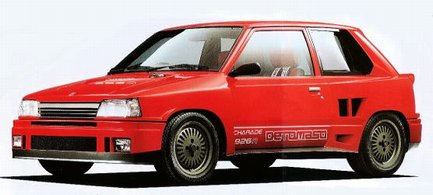
How an Argentinian race driver building supercars in Italy using American V8s gave us one of the best JDM hot hatches of the 80s and 90s
We've seen all sorts of rad Japanese cars from the 1980s and 90s explode in popularity and value of late, and we're especially excited to see rare, quirky models like the Daihatsu Charade DeTomaso gaining a newfound appreciation.
Daihatsu's Charade had a proud reputation as rallying's mighty mouse, capable of giving Quite A Lot of Bother to larger turbocharged four-wheel-drive rally cars in upper classes. It was able to do this thanks to its featherweight mass, compact stature and great handling, which also helped make the Charade a favourite among young drivers the world over.
So how did a bloke building supercars help give us an absolute cracker of a special edition Charade? Well, it is a long, multi-national story starting in Argentina and involving supercars.

Alejandro de Tomaso was an Argentinian fella who ended up in Italy in the 1950s. He raced in four Formula One Grand Prixs in that decade but soon started his own car company which produced low-volume high-performance road cars, including the Vallelunga, Deauville, Longchamp, Mangusta (the cover image) and the most famous: the Pantera (see above, in full, glorious GT5 spec).
These vehicles used an advanced (for the time) aluminium backbone construction, coupled with powerful, low-maintenance Ford V8s. Elvis Presley owned a Pantera in the early 1970s and famously shot it (with a pistol he kept in his boot) when it wouldn't hot-start after vapour-locking.

So what does this have to do with front-wheel-drive Daihatsu hot hatches? Well, Old Mate Alejandro loved buying automotive companies and starting car-related projects, which included building and selling Minis in the Italian market under the Innocenti brand. His search for a new engine to power said Italian Minis lead him to Daihatsu's doorstep in the early 1980s.
The Japanese manufacturer saw a golden opportunity to bring some flair to their brand by hooking up with a famed Italian supercar manufacturer, so they launched a sticker-and-glitter pack Charade in 1983, before planning something far spicier...

The widebody Charade 926R launched at the 1985 Tokyo Motor Show, featuring a twin-cam turbocharged 926cc four-banger mounted behind the front seats, driving the rear wheels. The 800kg, 116hp rocket could have been a real banger in the wild world of Group B rallying, but a string of fatal crashes during the 1985 season saw Group B banned and the 926R never had a chance.

Daihatsu launched the much-lauded G100-series Charade in 1987 and included a De Tomaso model in the line-up as a special edition, while the fourth-generation G200-series Charade of 1993 really brought some maturity to the De Tomaso.

Featuring Recaro bucket seats, a De Tomaso-designed body kit, leather Nardi sports steering wheel and five-spoke alloys, it also boasted an upgraded camshaft in the single-cam 1.6-litre turbo four-cylinder engine. Producing 91kW the GTI-based De Tomaso Charade was renowned as an absolute rip-snorter thanks to its very light tare weight (820kg), excellent handling and vivacious engine package.

Around 120,000 G200 GTI Charades were built and today they stand as a great, fun collectable model to relive a time when simple, light weight performance cars gave way more fun-per-kilometre than many larger, more powerful cars on offer.

![Limited Edition Car Poster [AUTOGRAPHED]](http://mightycarmods.com/cdn/shop/files/ONLY_45AUD_480x480.png?v=1765858723)


